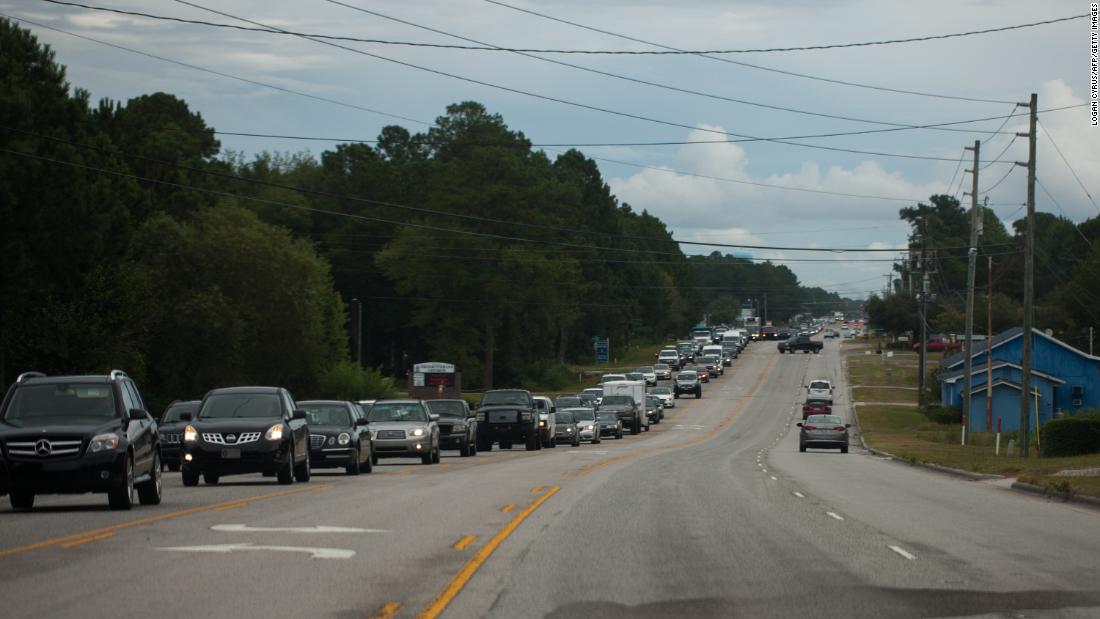[ad_1]
“More people are involved in this now — especially even Myrtle Beach, because the storm was not (previously) forecast to turn left toward you,” CNN meteorologist Chad Myers said Wednesday morning.
Forecast models predict a pause and a southward turn of the storm’s center late Friday, and it may not make landfall until roughly Saturday.
“This storm is … nothing like you’ve ever seen,” North Carolina Gov. Roy Cooper said Tuesday. “Even if you’ve ridden out storms before, this one is different. Don’t bet your life on riding out a monster.”
Latest developments
• Location: By 8 a.m. Wednesday, the storm was 530 miles southeast of Cape Fear, North Carolina, with maximum sustained winds of 130 mph.
• Some big dangers: The storm’s circulation could bring huge storm surges to the front-right of storm — covering much of North Carolina’s coast — and those effects also could extend to South Carolina if the storm stalls and turns left as predicted.
• Don’t stare at the eye: “We can’t focus on the eye on this thing, because (Florence is) 150 miles wide from one side to the other,” and tropical-storm-force winds extend up to 175 miles from center, Myers said.
• Rain and storm surges: Life-threatening storm surges — up to 13 feet — are expected along parts of the Carolina coasts. Up to 40 inches of rain could fall — bringing possible catastrophic flash flooding — to parts of the Carolinas through early next week, with heavy rain also likely in the Appalachians and Mid-Atlantic states, the National Hurricane Center said.
Residents flee as storm gets closer
More than 1 million people are under mandatory evacuations in the Carolinas and Virginia.
As the hurricane closed in, some residents wondered whether to ride it out. Allison Jones said she’s not taking any chances.
Her home in Hillsborough, North Carolina, is at risk for flooding, and her family and nearby relatives will ride out the storm in Chattanooga, Tennessee. The five adults, six children, and a dog and a cat, will leave their homes Wednesday.
The adults packed irreplaceable items such as photo albums and heirlooms while the children stuffed their favorite toys, blankets and books in their bags.
“Honestly, it tears me up thinking that what if in the end of this, this is all we have left,” Jones said. “I wish I had more time to sort through and grab more of the sentimental items.”
‘My home is all my wife and I have’
Tim Terman’s house in Southport, North Carolina, is about 20 feet above sea level. He’s staying put — for now.
“Once you leave, hard to get back in to check on damage,” he said. “My home is all my wife and I have, materially speaking, a lifetime of stuff.”
Residents along the coast boarded up their homes, lined up at gas stations and emptied supermarket shelves.
On Ocracoke Island along North Carolina’s Outer Banks, Kelley Shinn and her partner packed their Jeep with clothes and other things and took a ferry to the mainland. From there, they headed to her father’s home in Ohio.
“It’s surreal to think we may have nothing to go home to,” she said. “We’ve never left for a storm before. But a storm surge of 20 feet could easily wipe this island out.”
Mayor Joe Benson of Carolina Beach, a small town near Wilmington with a permanent population of about 6,300, said he believes half of the residents have stayed on the island.
Emergencies declared in several states
The Federal Emergency Management Agency warned that storm surge watches and warnings are in effect for the entire North Carolina coast and parts of South Carolina. It urged residents to heed evacuation orders.
Officials in several states have declared states of emergency, including Virginia and Maryland, where coastal areas are still recovering from summer storms.
“We are hoping for the best and preparing for the worst,” Maryland Gov. Larry Hogan said, noting that Florence could cause catastrophic flooding in his state.
Traffic redirected away from the coast
In South Carolina, traffic in all lanes of Interstate 26 from Charleston to Columbia has been directed away from the coast, South Carolina Gov. Henry McMaster said.
Residents in hurricane evacuation zones had until noon Tuesday to evacuate. McMaster ordered the closure of schools and state government offices for nonessential personnel in affected areas.
Some schools in inland counties will be used as shelters, and officials urged families with pets to board them with veterinarians, kennels or other facilities in nonvulnerable areas.
“Pets are not allowed inside Red Cross evacuation shelters,” McMaster said.
North Carolina officials evacuated long-term care facilities and hundreds of prisoners in vulnerable areas, and also closed state parks, museums and other attractions.
“Residents in central North Carolina should be prepared to feel the impact of the storm from Thursday night through at least Monday due to threat of flooding and widespread and prolonged power outages,” Gov. Cooper said.
In Virginia, mandatory evacuations began Tuesday for about 245,000 residents in a portion of the Eastern Shore area.
Florence could have devastating impacts in Virginia, including storm surges, inland flooding, downed trees and power outages, Gov. Ralph Northam said.
CNN’s Kaylee Hartung reported from Carolina Beach, and Jason Hanna and Faith Karimi wrote in Atlanta. CNN’s Justin Gamble, Amanda Jackson, Paul P. Murphy, Chuck Johnston, Nick Valencia, Michelle Krupa and Keith Allen contributed to this report.
[ad_2]
Source link







